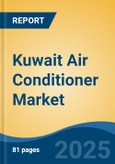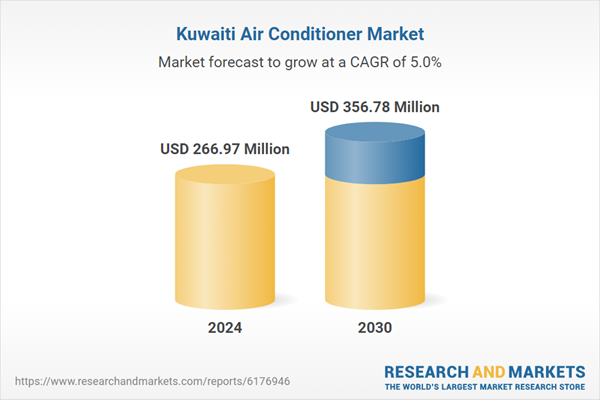Speak directly to the analyst to clarify any post sales queries you may have.
10% Free customizationThis report comes with 10% free customization, enabling you to add data that meets your specific business needs.
Additionally, the steady rise in tourist arrivals from approximately 9.8 million in 2023 to a projected 11.8 million by 2028, growing at an average annual rate of 2.9% is significantly driving demand in the Kuwait air conditioner market. This growth fuels expansion in the hospitality and retail sectors, prompting hotels, resorts, shopping centers, and entertainment venues to invest in advanced cooling solutions to ensure visitor comfort. As tourism infrastructure expands to accommodate increasing footfall, the need for energy-efficient, high-performance air conditioning systems rises accordingly, further stimulating market growth across both the commercial and service-oriented segments.
Key Market Drivers
Extreme Climatic Conditions
Kuwait experiences one of the most extreme climates in the world, with summer temperatures frequently exceeding 50°C. This intense heat creates a critical need for reliable cooling solutions in both residential and commercial spaces. Air conditioners are no longer considered luxury appliances but essential household and workplace utilities. This climatic necessity significantly drives the adoption of air conditioning systems across all income levels and sectors. The average temperature in Kuwait rose to 27.52°C in 2023 from 27.49°C in 2022, continuing a long-term upward trend from the historical average of 25.45°C recorded between 1901 and 2023. This gradual rise in temperature highlights the growing impact of climate change and intensifies the demand for effective cooling solutions.Moreover, due to prolonged periods of high temperatures - spanning nearly eight months of the year - there is sustained, year-round demand for cooling products. This leads to frequent usage, which accelerates the wear and tear of units and increases the frequency of replacements and maintenance, further propelling market growth. The harsh weather also drives innovation among manufacturers to design systems specifically built for durability and high-efficiency performance under extreme conditions.
Key Market Challenges
Dependence on Imports and Limited Local Manufacturing
Kuwait relies heavily on imports for its air conditioning systems, components, and spare parts, with limited domestic manufacturing capacity. Most of the leading AC brands operating in the country source their products from global manufacturers based in countries like China, Japan, South Korea, and the United States. This heavy dependence on foreign suppliers makes the local market vulnerable to global supply chain disruptions, currency fluctuations, and import tariffs.Events such as the COVID-19 pandemic and geopolitical tensions have already highlighted the fragility of global supply chains. Delays in shipments or increases in international freight costs directly affect product availability and pricing in Kuwait. Moreover, fluctuations in exchange rates can lead to unexpected price increases, making AC units less affordable for price-sensitive consumers. The lack of a robust local manufacturing or assembly ecosystem also limits opportunities for product customization and rapid innovation suited to regional climate and consumer preferences.
Key Market Trends
Integration of Smart and Connected Technologies
The increasing digitalization of consumer lifestyles in Kuwait has led to the growing adoption of smart and connected air conditioners. Consumers are showing strong interest in AC units that offer advanced control features, remote access, scheduling, automation, and integration with smart home ecosystems. Wi-Fi-enabled ACs that can be operated through mobile apps or voice assistants (like Amazon Alexa and Google Assistant) are becoming particularly popular among tech-savvy urban users.Manufacturers are capitalizing on this trend by launching smart air conditioners equipped with artificial intelligence (AI), occupancy sensors, and temperature optimization algorithms that enhance user comfort while reducing energy consumption. The appeal of smart features is not limited to residential users commercial entities such as office buildings, malls, and hospitals are also investing in centralized smart systems that help monitor energy use, predict maintenance requirements, and ensure better indoor air quality. As the smart home market in Kuwait continues to expand, smart AC adoption is expected to grow significantly.
Key Market Players
- LG Electronics Gulf FZE
- Daikin McQuay Middle East FZE
- Air-conditioning & Heating International Carrier FZC
- Zamil Air Conditioners Holding Co. Ltd.
- Samsung Gulf Electronics FZE
- Fujitsu General Middle East FZE
- Johnson Hitachi Ltd
- Gree Electric Appliances, Inc.
- York Air-conditioning & Refrigeration FZE
- Trane Middle East
Report Scope:
In this report, the Kuwait Air Conditioner Market has been segmented into the following categories, in addition to the industry trends which have also been detailed below:Kuwait Air Conditioner Market, By Product Type:
- Splits
- VRFs
- Chillers
- Windows
- Others
- Kuwait Air Conditioner Market, By End Use
- Residential
- Commercial/Industrial
Kuwait Air Conditioner Market, By Region:
- Capital Governorate
- Hawalli Governorate
- Ahmadi Governorate
Competitive Landscape
Company Profiles: Detailed analysis of the major companies present in the Kuwait Air Conditioner Market.Available Customizations:
With the given market data, the publisher offers customizations according to a company's specific needs. The following customization options are available for the report.Company Information
- Detailed analysis and profiling of additional market players (up to five).
This product will be delivered within 1-3 business days.
Table of Contents
Companies Mentioned
- LG Electronics Gulf FZE
- Daikin McQuay Middle East FZE
- Air-conditioning & Heating International Carrier FZC
- Zamil Air Conditioners Holding Co. Ltd.
- Samsung Gulf Electronics FZE
- Fujitsu General Middle East FZE
- Johnson Hitachi Ltd
- Gree Electric Appliances, Inc.
- York Air-conditioning & Refrigeration FZE
- Trane Middle East
Table Information
| Report Attribute | Details |
|---|---|
| No. of Pages | 81 |
| Published | September 2025 |
| Forecast Period | 2024 - 2030 |
| Estimated Market Value ( USD | $ 266.97 Million |
| Forecasted Market Value ( USD | $ 356.78 Million |
| Compound Annual Growth Rate | 5.0% |
| Regions Covered | Kuwait |
| No. of Companies Mentioned | 10 |









